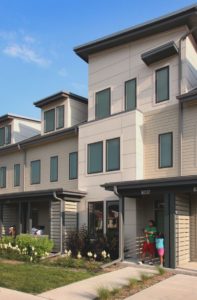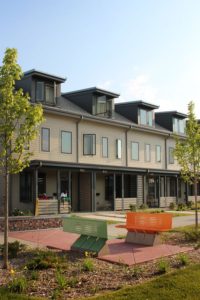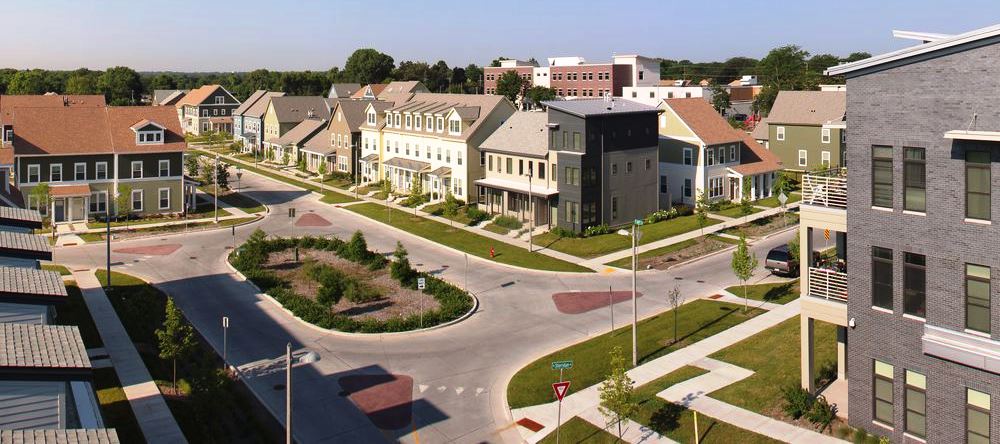Sprawling onto farmland on the fringes of Milwaukee, Wisconsin back in the 1950s, the Westlawn Gardens public housing project was a product of its era. A 75-acre array of humble brick-and-frame structures looked more like military barracks than a neighborhood designed to provide a decent quality of life families.
 Lined with multicolored town homes and new streetscaping, the area looks radically different today. After deferred maintenance and occasional flooding made it clear the old post-war structures required more than an upgrade, Milwaukee decided simple renovations wouldn’t be enough.
Lined with multicolored town homes and new streetscaping, the area looks radically different today. After deferred maintenance and occasional flooding made it clear the old post-war structures required more than an upgrade, Milwaukee decided simple renovations wouldn’t be enough.
The ongoing demolition, redesign, and rebuilding of Wisconsin’s largest public housing community hasn’t just created a new place to live. Though innovative, community-oriented planning and design, Westlawn has, supporters hope, become a model for rebuilding neighborhoods. “One of the things we really want to emphasize here is that this isn’t your father or mother’s public housing,” says Warren Jones, the vice president of construction for the Housing Authority of the City of Milwaukee (HACM). “This is now a place that anybody would like to live.”
Back in September of 2015, the U.S. Department of Housing and Urban Development (HUD) gave five communities, including Milwaukee, had received a combined $150 million to redevelop severely distressed public housing and revitalize the surrounding neighborhoods. HUD also awarded those Choice Neighborhoods Initiative Implementation Grants to city and housing authority partnerships in Atlanta, Georgia; Kansas City, Missouri; Memphis, Tennessee; and Sacramento, California, all of whom then began the process of transforming, rehabilitating and preserving antiquated—usually blighted—public housing.
The City of Milwaukee and the Housing Authority of the City of Milwaukee were awarded a $30 million Choice Neighborhoods Implementation Grant to redevelop the Westlawn public housing development and revitalize the surrounding Westlawn neighborhood. As with so many Choice grant recipients, the results are spectacular. The ROI on Choice grants averages about 9:1. For every $1 in Choice Neighborhoods funding cities receive, the awardees and their partners leverage an additional $9 in public and private funding for their revitalization projects.
A total of 394 deteriorating public housing apartments were demolished during the renewal process. The Transformation Plan included the redevelopment of 708 new mixed-income housing units, including 394 replacement units, both on the Westlawn site and in the surrounding neighborhood. In addition, the plan included strategic investments to improve the entire neighborhood by reducing the negative effects of foreclosures, improving access to retail and transportation, and strengthening families’ health and employment.
As part of the Obama administration’s overall drive to reinvest in neighborhoods of concentrated poverty, the Choice Neighborhoods Initiative was intended to transform distressed public and assisted housing into sustainable, mixed-income housing with access to community assets and services and to support positive outcomes for families living in the development and in the community. Those five 2015 awardees proposed to replace more than 1,650 distressed public housing units with more than 2,800 new mixed-income, mixed-use housing units as part of an overall effort to revitalize neighborhoods.
“The Choice Neighborhoods Initiative is responsible for transforming what were once vacant lots, crumbling parks and storefronts and distressed housing into vibrant communities,” said then-HUD Secretary Julian Castro when announcing those 2015 grants. “It has become one of our nation’s most important tools in the fight to ensure that every family – no matter where they live – has the resources and strong foundation to succeed.”
 But the overall neighborhood redevelopment won’t stop when the constructions crews go home. The Choice Neighborhoods Grant will fund numerous initiatives with local schools, community groups, and even businesses to help residents access new opportunities.
But the overall neighborhood redevelopment won’t stop when the constructions crews go home. The Choice Neighborhoods Grant will fund numerous initiatives with local schools, community groups, and even businesses to help residents access new opportunities.
“Using the redevelopment of public housing as a foundation is a key element,” says Paul Williams, the Choice Neighborhood Initiative Coordinator. “It allows us to have an impact on the quality of life in so many ways.“
It’s already paid off. The Milwaukee Bucks, the city’s NBA team, and Johnson Controls, an international industrial firm with headquarters a mile away from Westlawn, partnered to invest in a multi-sport complex for the neighborhood, and a new training center for students and adults seeking careers in the health industry is taking shape in the area.
What’s more, Milwaukee’s Redevelopment Authority committed to making $1 million in small business loans, while HACM donated bicycles so local police could increase beat patrols.
The redevelopment of Westlawn, which just won the American Planning Association’s Opportunity and Empowerment Award, showcases how public housing, and the public’s perception of such housing, can be reimagined and reoriented.
All images courtesy of Brian Tomaino / Torti Gallas and Partners, Inc.
See Curbed article by Patrick Sisson.
See the Westlawn Gardens page on the Milwaukee housing Authority’s website.

